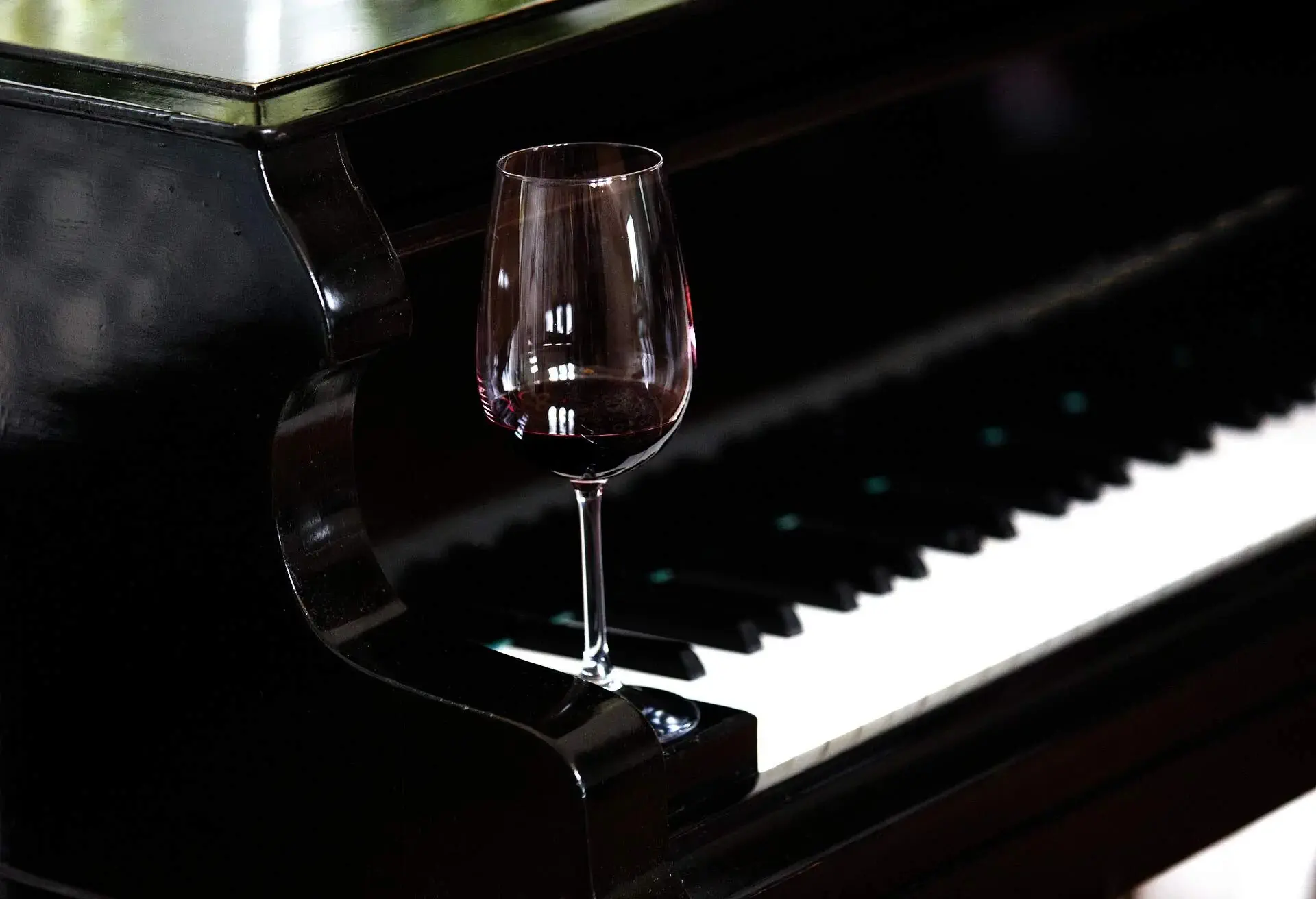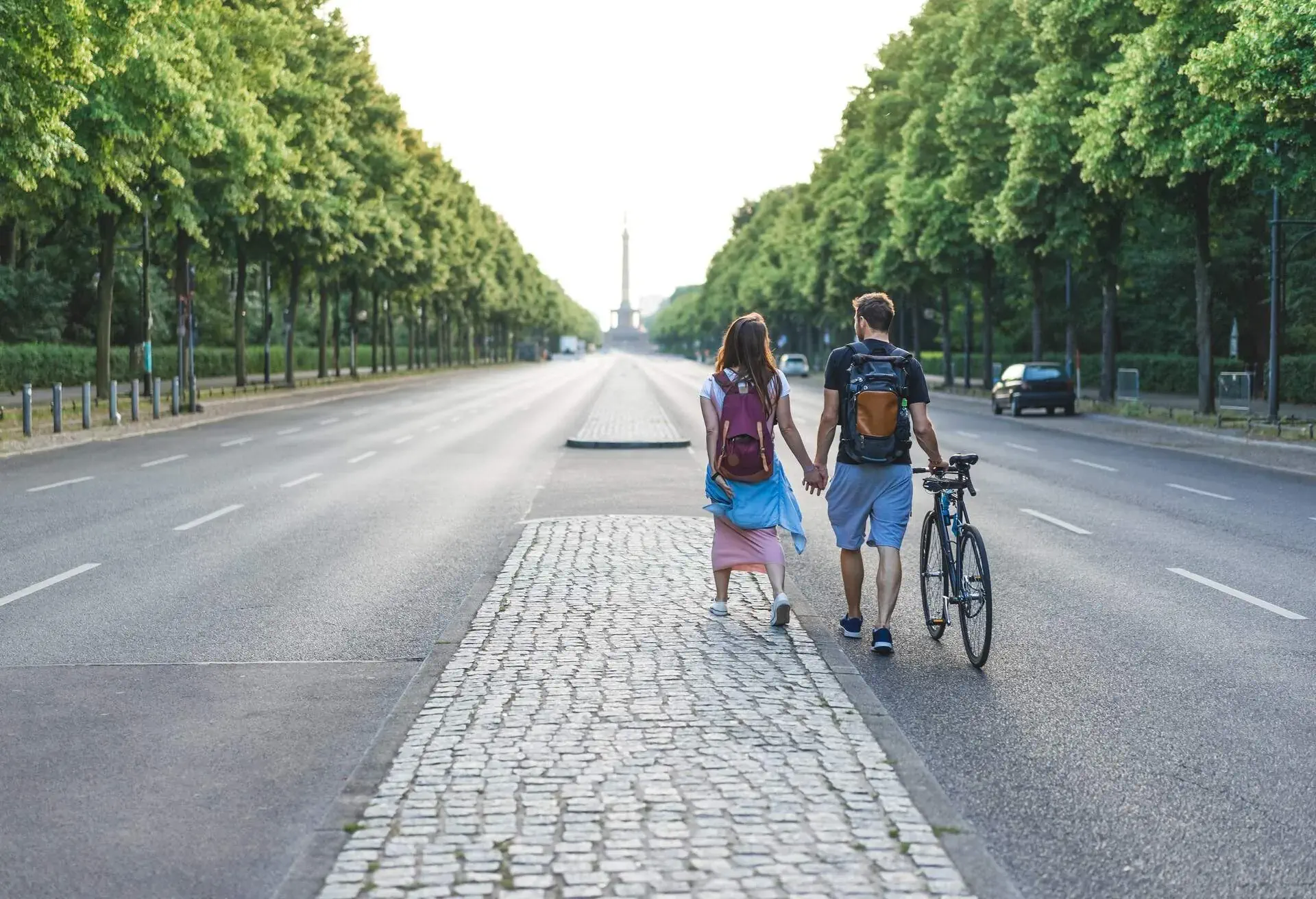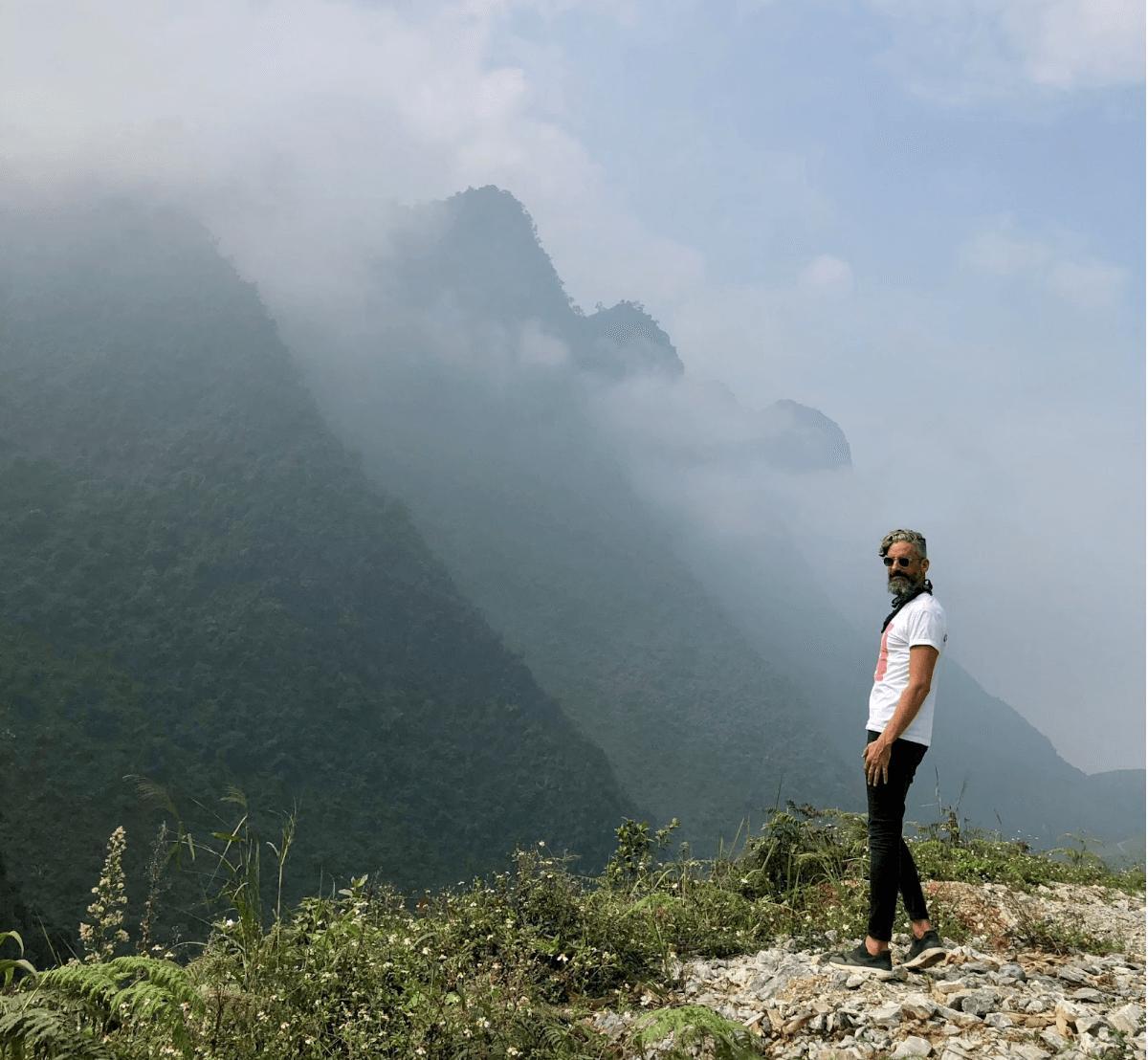Day or night, you’ll never be short of things to do in Berlin. Undoubtedly shaped by its years of separation during the Cold War, it has emerged triumphant as a beacon of freedom, creativity and resilience.
Indulge in Berlin’s famed nightlife, dip a toe into its vast reserves of history and culture, laze on the shores of its many lakes.
With friends or family, alone or en masse, Berlin has the glamor and grime to satisfy the most eclectic of tastes. You’re going to love it.
What are the best things to do in Berlin?

Berlin is a city more starkly shaped by its modern history than most. The influence of its 45-year occupation and 28-year division shows itself everywhere. From the remnants of the Berlin Wall to the bullet holes still sprayed across building facades, that history plays an intrinsic part of any visit.
Since the wall came down, the city and its people have found a powerful new identity. Differing ideologies have transformed into easygoing diversity. Historic buildings rub shoulders with modern architecture. The food scene has gone global with amazing Asian and Turkish restaurants stealing the culinary show, not to mention the ample vegan options.
And the Berlin nightlife? There’s a reason it has such a global reputation, but let’s just say you need to experience it to really know. In the years I lived there I had many of the best, longest, and most chaotic nights of my life.
With so much to see and do and such huge variation, it’s best to go with a plan. Use my selection of favorite things to do in Berlin as a structure, but don’t hesitate to go off the beaten track. That’s where you’ll find many of the city’s transient treasures.
And if you want more help planning your entire trip, from the best Berlin sights to where to eat and stay, our Berlin Travel Guide has the answers.
- Reichstag
- Urban Nation
- Bike Berlin
- River Spree and waterways
- Museuminsel
- Memorial to the Murdered Jews of Europe
- Schwarze Traube
- Fotoautomat
- Liquidrom
- Berlin Wall
- Piano Salon Christophori
- Ernst
- Teufelsberg
- Schloss Charlottenburg
- Tempelhofer Feld
- Brandenburg lakes
- Tiergarten
- Badeschiff
- Berlin nightlife
1. Wind your way up the spiral of the Reichstag

The neo-Baroque building that’s home to the German Bundestag (parliament) is a triumph of hope over adversity. It’s been bombed and burned, survived the rise of the Nazis and the art of Christo, and has successfully merged the old and new to startling effect. The Reichstag is one of Berlin’s most important buildings.
Enter the lower assembly room and you soon find yourself spiraling upwards into the huge glass dome that curves into the sky. Designed by Norman Foster, it floods the space with light, creating a sense of openness and transparency. Step out onto the roof terrace for lovely views of the city.
Chances are it will be busy whatever time you go, but there’s room enough for everyone. Nowadays you need to book online at least three days before your visit, but it’s completely free. Be sure to check your dates on the website, as the Dome does close several times a year for cleaning and maintenance.
2. Embrace street art at Urban Nation

Love or loathe it, there’s no getting away from Berlin’s graffiti scene. An outlet for artists and anarchists, the disenchanted and the disenfranchised, it is a constant across the city.
From political slogans daubed on the socialist blocks of Friedrichshain to intricate artworks on the modern towers of Mitte, the city has embraced street art in all its forms. So much so that Berlin is home to the world’s first museum dedicated to the art form.
From Blek le Rat to Banksy, Urban Nation hosts works from famed as well as up-and-coming artists. Its current exhibition, “Talking… & Other Banana Skins” runs until 2024. Easy to reach in Schöneberg, it’s open every day except Monday and entry is free.
3. See Berlin by bike

Berliners love to cycle. The city is flat, parks and canals are commonplace, and there are more than 560 miles of cycle paths snaking their way to the best Berlin sights and tourist attractions. Yep, two wheels are undoubtedly the best way to explore.
Consider buying a bike for a stay longer than a week, as it’ll be much cheaper than renting one. There are bike shops and forums across the city buying and selling daily. Rent or buy, just beware of the ubiquitous cobbles and tram lines that crisscross city streets. They’ve brought many a cyclist down in a painful crunch over the years, myself included (more than once).
There are many routes to follow but few are more profound than the Berlin Wall Trail. Start at the East Side Gallery in Friedrichshain and follow some or all of the double row of cobblestones that mark its line for a 100-mile loop through the city.
Watch for the memorial markers set into the roads and sidewalks that commemorate those who died trying to cross it.
4. Cruise the waterways on a houseboat

Berlin’s main river is the Spree. It snakes its way north through the city before meeting and disappearing into the River Havel and provides some spectacular riverside sights along its route. There are, of course, a bounty of hungry tour operators offering city cruises that also take in the Landwehrkanal and some of Berlin’s lakes.
Much more fun though is to hire your own boat and go at your pace. The lovely hand-crafted Wasserkutsche houseboats run on silent electric motors and have everything you need for a day or two on the water. That gives you the time to explore every watery aspect of the city – get a close-up of the huge Molecule Man, sail under the eccentric Oberbaumbrücke, and drift over forest-fenced lakes.
Boats are for two to six people and Wasserkutsche can advise you on tours, routes, and essentials like charging stations along the way.
5. Cross the bridge to Museumsinsel

Also known as Museum Island, Berlin’s cluster of five extraordinary museums on an island in the Spree is a global landmark of culture and history. A UNESCO World Heritage Site, each museum covers a different aspect of German history and art, from the Stone Age to the 19th century.
For antiquities head to the Altes Museum and Pergamonmuseum (although the latter is closed until October 2023 for renovations). For Renaissance sculpture, the Bode-Museum should be your first stop. You’ll find more 19th-century European art than you can handle at the Alte Nationalgalerie.
Last but not least, the Neues Museum showcases the histories of world cultures and is home to Berlin’s most important and controversial artifact, the bust of Nefertiti.
KAYAK top tip: Don’t attempt Museumsinsel in one go, or indeed in one trip. Pick one or two museums and do them properly, as there’s so much to see. You can always come back to see the others!
6. Visit the Memorial to the Murdered Jews of Europe

Built in remembrance of the six million Jews killed during the Holocaust, the Memorial to the Murdered Jews of Europe was completed in 2004. Occupying an entire city block close to the Brandenburg Gate, its massive scale and stark minimalism combine to powerful effect.
Designed to be interacted with, it comprises 2,711 “stelae”; concrete slabs of the exact same dimension but varying in size and layout to form a network of bewildering corridors. Walking through it is moving to the point of being overwhelming. Few who visit would argue its impact.
The holocaust memorial is free to wander at any point. You can also join guided group tours or join a wider tour of remembrance, but you’ll need to enquire online in advance.
7. Sip sublime cocktails at Schwarze Traube

If there’s one thing Berlin has no shortage of, it’s unnervingly cool yet unique bars. Walk the cobbled streets of Friedrichshain and Kreuzberg and you can’t stumble without landing on a vintage wooden chair, Moscow Mule in hand.
A mainstay of the scene is Schwarze Traube (“black grape”). In three simple yet artful rooms decorated from the many flea markets that ply Berlin’s streets, you can sup the best cocktails in the city. The menu changes daily and only ever consists of three drinks, but you won’t hear anyone complaining.
Don’t let the unwelcome exterior put you off – inside is a den of cozy iniquity, done as only Berlin can. Open till late every day from 19:00 and as with most bars in Berlin, it’s cash only.
8. Satisfy your selfie cravings in a Fotoautomat

Another quirky characteristic of Berlin is the huge number of Fotoautomat you see dotted about the city. Lovingly refurbished and maintained, you’ll find these vintage photo booths in the grungy cool urban areas – Prenzlauer Berg, Kreuzberg, NeuKölln and Treptow-Köpenick.
When I was living in Berlin, my girlfriend and I made it a point to stop and shoot a reel at each one we saw at least once. I called the photo project “zwei euros” for the two euro coin each Fotoautomat demands for its services.
With every set of photos developing differently, they can create a wonderful record of your visit. To this day, my Fotoautomat pics remain my most treasured possession from our time in the city.
9. Shed your inhibitions (and clothes) at Liquidrom

After a strong dose of Berlin nightlife, few experiences are as recuperative or surreal as a day spent floating in the Liquidrom spa at Tempodrom. A WWII train station turned abstract tent-like structure, it looks crazy from the outside and feels crazy on the inside.
Soak your aches, sins, and sorrows away in the aroma steam baths, Himalayan salt sauna, and outdoor onsen. You’ll need to strip down for the sauna, as Liquidrom follows Freikörperkultur – literally ‘free body culture’, the German idea of nudism.
If you prefer to keep your clothes on, bypass the sauna and head for the show-stopping saltwater floating pool. Dark and moody with colored light displays, it’s a relaxing place to float an hour or two away. Dip your head under the water to listen to music, which ranges from classical to techno depending on the day. As the staff are fond of saying, “let yourself drift”.
Liquidrom is open every day of the year till late but you should book online as, not surprisingly, it’s popular.
10. Explore the remnants of the Berlin Wall

There are few vestiges remaining of the wall. A symbol that cleaved its way through the streets and lives of Berliners for nearly 30 years. Its fall was one of the most seismic events in modern history and changed the world’s political landscape.
But there are some sections that remain, both in memorial and defiance. Foremost is the Brandenburg Gate which came to symbolize the division between east and west but was reborn as a symbol of unity on the wall’s fall.
Checkpoint Charlie, the gateway for foreigners and diplomats between Cold War Berlins, remains but has become a tourist trap and lost much of its impact. Far more insightful is the Gedenkstätte Berliner Mauer, the mile-long Berlin Wall Memorial on Bernauer Strasse.
Offering a very different take is the East Side Gallery on the banks of the Spree in Friedrichshain. A series of 105 permanent murals painted on a section of the wall, they demonstrate the people taking ownership of something they were for so long forbidden to touch. Stroll along them and it’s hard not to get swept up in the sense of euphoria and mania they create.
11. Go classical at Piano Salon Christophori

A night at Piano Salon Christophori is the epitome of an off-the-beaten-path Berlin experience. Located in the Wedding district, it is by day a workshop where craftspeople and musicians lovingly restore grand and historic forte pianos.
Every two to three weeks it transforms into an incredibly personal and atmospheric music venue that pays homage to the instruments repaired there. Classical or jazz, its music reflects the spirit of the piano salons like Parisian Maison Erard and the Salle Pleyel.
Check the online calendar for upcoming concerts, where you can also book in advance (all in German so you may need to translate). Tickets are €15, but that usually includes the wine you’ll quaff as you chat after the concert.
It’s a bit of a trek from the nearest station at Pankstrasse UBahn, but it’s well worth the effort – one of the most spine-tingling evenings I’ve ever had in Berlin.
12. Eat at Ernst

While you’re in Wedding, it would be remiss not to treat yourself to one of Berlin’s best meals at Ernst. One of the hottest tickets in town despite its external appearance, it is typical Berlin. You’ll need to book well in advance and at €250 a seat, prepaid, it’s not cheap. But it is exceptional.
Ernst is a private dining experience. Chef Dylan Watson-Brown serves eight lucky guests directly at the kitchen counter, encouraging them to interact with the chefs. His style is grounded in Japanese cuisine from his time at Tokyo’s three Michelin star Ryugin, but has a focus on regional seasonal produce.
It is, of course, sensational. A tasting menu treat you need to plan ahead and splash out for, but one you won’t forget. If you have food allergies, check before you book.
KAYAK top tip: For more Japanese inspired fine dining check out 893 Ryōtei. Hidden behind a mirrored wall covered in graffiti, 893 is a trendy and delicious treat — booking in advance is a must.
13. Join the conspiracy at Teufelsberg

Towering over the Grunewald forest to Berlin’s west, the undeniably phallic Teufelsberg draws both the curious and the counter-cultured to its geodesic shapes. There’s little that isn’t strange about this abandoned NSA field station, first built to eavesdrop on communist East Berlin.
It sits atop Berlin’s highest hill, a 260-foot artificial mound built from the rubble of some 400,000 buildings destroyed during WWII. It stands as a landmark, vandalized and graffitied, reclaimed from the authorities by the people of Berlin. Some order has been restored, however.
There’s now a small cash-only entry fee and dedicated opening hours. You’ll find one of the world’s biggest street art galleries sprayed across every surface. The roof offers my favorite view of Berlin’s skyline and the city’s most spectacular sunsets. There are even guided tours and a bar open on weekends.
Teufelsberg is an effort to visit. You’ll need to take the S-Bahn to Heerstraße or Grunewald and walk for half an hour through the forest – stick to the paths as wild boar roam the woods. And it’s important to remember the whole area is rough and tumble. Abandoned for many years, there are holes, edges, drops, and other hazards, so be careful as you explore!
KAYAK top tip: On a hot day, head to Teufelssee, a lovely lake five minutes walk from the Grunewald S-Bahn where you can swim, naked or in bathers. There’s shade, a sandy beach, and a little cafe selling snacks next door. Oh, and it’s free – dive in!
14. Marvel at the opulence of Schloss Charlottenburg

Sumptuous Charlottenburg Palace is a baroque feast for the eyes. The Palace’s many buildings and lush gardens are a showcase of the pomp and grandeur of the Prussian royals. Over five centuries it was the favored retreat of the Hohenzollern ruling family.
In that time they grew it into the exquisite collection of palaces, apartments, halls and mausoleums we see today. Lavishly decorated and beautifully presented, you can easily lose a day exploring its treasures, strolling and picnicking in the grounds.
Open daily except Mondays year-round, you can buy tickets there but it gets busy (especially on sunny days) so is worth booking in advance online. And if you like Schloss Charlottenburg, you’re going to love Sanssouci.
15. People-watch at Tempelhofer Feld

I spent many Sundays wandering around the former Tempelhof airport, people watching and basking in the relaxed pace of Berlin life. Closed as an airport in 2008, the 368-hectare space was reclaimed for the citizens as a recreation ground in the middle of the city.
Tempelhofer is a place where everyday life unfolds. Joggers and dog walkers, cyclists and skaters, land kite surfers and kite flyers; all take advantage of its grass areas and runways. There’s a 2.5 hectare barbecue area and allotments where locals grow their own fruit and veg. And of course, there are Berlin’s ubiquitous beer gardens.
A window into Berlin life, it’s a lovely place to spend an afternoon. Free entry from sunrise to sunset, there are three entrances at Columbiadamm, Tempelhofer Damm and Oderstrasse.
16. Step out of the city and into the Berlin lakes

As urban as Berlin undeniably is, it’s also surrounded by many spectacular tracts of nature, nowhere more so than its lakes. Brandenburg, the state Berlin is surrounded by, is known as the “land of 3,000 lakes” for good reason.
Wild swimming, naked swimming, boating, sunbathing – all are popular activities well catered to by the very different lakes within easy access by public transport.
Strandbad Wannsee is excellent for families with its pedalos and playgrounds, boat hire and beer gardens. Strandbad Plötzensee with its long beach and lovely swimming is just 30 minutes from the city center for a quick dip.
My favorite was always Müggelsee, Berlin’s largest lake. Surrounded by forests, there are lovely isolated pockets to spend a day swimming and snoozing in solitude. Rent an electric boat and pootle silently through the canals of New Venice for a glimpse into a more sedate way of life.
Many lakes have dedicated swimming areas attended by lifeguards but there are few if any rules to stop you from swimming wherever you like. Always be very careful to make sure the waters are warm and safe to swim in, watch for boats, and never swim alone.
17. Search out the beer gardens of Tiergarten

Tiergarten translates as “animal garden” likely in reference to its original purpose as a hunting ground for boar and pheasants. Today it’s a huge city park, beautifully landscaped with grasslands and wood groves, shaded seating, and rambling paths. And, with a little searching, some of the best beer gardens in Berlin.
In the southeast of the park, you’ll find Café am Neuen See. Often busy, it can suffer slow service but all is forgiven for its scenic lakeside setting. Order some Bavarian staples, a few oversized beers, sit back and let the evening drift by.
In the north, the equally lovely Teehaus im Englischen Garten is my pick. The thatched building holds a huge indoor restaurant and outdoor garden overlooking a pond. The beers are cold, the menu is simple and the schnitzel is always the right decision.
KAYAK top tip: Some of the KAYAK team’s other favorite spots include Schleusenkrug and Cassiopeia Sommergarten.
18. Swim on the Spree at Badeschiff

Built into a floating barge on the River Spree opposite Arena Berlin, the Badeschiff “bathing ship” is a city pool with a twist. One hundred feet long and six feet deep, it’s connected to a ramshackle beach and bar area by a wooden gangplank usually draped with tattooed sunbathers.
I love swimming in Badeschiff because it gives such a unique perspective on the city from the river. An excursion on a rented paddleboard is also a great way to explore the Spree a little more. As evening descends, DJs move into wooden booths and set the mood for the coming night.
Seasonal and with varying opening times, you’ll need to book a dedicated time slot in advance online. Don’t forget your bathing costume as this one isn’t nudist, but there are lockers on site for your stuff.
19. Dive headfirst into Berlin nightlife

Extreme, diverse, deranged, hedonistic – there aren’t enough adjectives to encapsulate the spectrum of bars, clubs and experiences that shape Berlin’s daily plunge into darkness.
It’s home to the world’s most famous clubs and is the global center of electronic and techno music. It’s fiercely protected by cultural ambassadors who recognise its importance and value to the city’s identity. It’s the sole reason many people move to Berlin.
Among its most famous clubs are the erotic fetishist KitKatClub, the grungy ://about blank where electronica is king, and of course, Berghain. Long the world’s most famous (and infamous) club, it’s housed in a huge factory in Friedrichshain. Its pulsing sound system, huge dance floor and weekend-long parties are the stuff of legend and a rite of passage for many Berliners.
All you have to do is suffer the hours-long queue and get past the notoriously unwelcoming doorman, and you’re in for the night of your life.
How did we choose what goes in our guide to the 19 best things to do in Berlin?

I lived in Berlin for just shy of two years, leaving just before the pandemic closed much of the world down. I lived in seven different apartments (not unusual thanks to Berlin’s cutthroat renting scene) across different areas of the city. But most of the time I lived the cliché and stayed in Friedrichshain, Kreuzberg, NeuKölln, and Prenzlauer Berg.
I explored a lot and this compilation of the best things to do in Berlin is borne from those explorations, mixed of course with some of the “must-do” sights and tourist attractions. It’s been helped too by the KAYAK team, many of whom live in the city, as it’s our European HQ.
Visiting Berlin: FAQs
Do I need a car in Berlin?

That’s a hard no. While you can easily drive in the city, the excellent U-Bahn and S-Bahn trains and trams are frequent and far-reaching. I joined Emmy, an electric moped rental app that makes it super easy to get around the city relatively inexpensively.
The ultimate transport is, however, the humble bicycle. Rent or buy, you’ll need a good lock and make sure you use it – bike theft (or “borrowing”) is commonplace.
When is a nice time to visit Berlin?

There are plenty of things to do in Berlin during the winter months, but it can get blisteringly cold with temperatures well below zero and howling winds channeling down those wide avenues and boulevards. The Christmas markets are amazing though if you can get enough glühwein in you to stay warm.
Spring and summer are the optimal months, as the parks and gardens come to life, as do the streets with cafés, bars, and restaurants spilling out onto the sidewalks. Yes, it’s busier and things are a little more expensive, but the sun more than makes up for it.
How long should I spend in Berlin?

Berlin has enough going on to suit all tastes. It’s fantastic for a weekend break, be that a hedonistic deep dive into its famous clubs or a cultural exploration of its spectacular museums and galleries. You can of course stay far longer – a week would fly by. That proximity to the surrounding forests and lakes of Brandenburg offers great respite should the urbanity of it all overwhelm you.
Is Berlin safe?

Berlin is safe, but it has its edgy areas and petty street crime is not uncommon. Avoid the parks after dark, especially Görlitzer park in Kreuzberg (which is lovely and lively in the day). Berlin is a city of immigrants and you’ll hear English spoken just as much as German in most places (more so in some). Tourists and visitors are a part of everyday life and most have no problems at all.
Does Berlin have tourist passes?

Yes, several. Consider getting a money-saving Berlin Welcome Card, which offers good reductions on public transport and discounts on many attractions.
There are a whopping 170 museums in Berlin so, depending on how many museums you wish to visit, you can buy tailored museum passes to get more value for your money.






